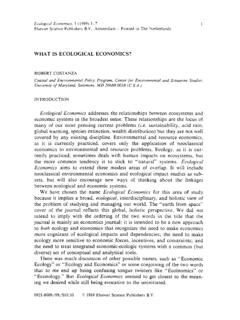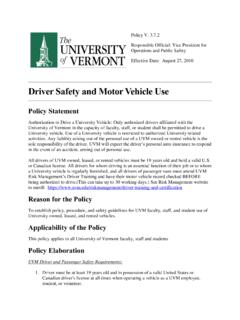Transcription of Growing Elderberries - University of Vermont
1 I GrowingElderberries:A PRODUCTION MANUALAND ENTERPRISE VIABILITY GUIDE FOR Vermont AND THE NORTHEASTGROWING Elderberries : A PRODUCTION MANUAL AND ENTERPRISE VIABILITY GUIDE FOR Vermont AND THE NORTHEASTF unding for UVM Extension s Elderberry Project was provided in part by grants from the Working Lands Enterprise Initiative ( ), and with a Rural Business Enterprise Grant from USDA Rural Development through the Vermont Housing and Conservation Board and the Northern Border Regional Commission and Northern Community Investment photos: Tori Lee Jackson, University of Maine ExtensionSpecial thanks to: Patrick Byers of University of Missouri Extension for the use of photographs and previously published materials; Michelle Graziosi and Elizabeth Brownlee for the use of information on Multifunctional Riparian Buffers; Ben Waterman for photographs and review of selected sections; Cathy Yandow and Cheryl Herrick for editorial assistance; Tamara Smith for graphic design; and Tori Lee Jackson, Abbie Sewall, John Hayden, David Fried, Todd Hardie, Guido Mase and Jennifer Brown for the use of Extension helps individuals and communities put research-based knowledge to work.
2 Issued in furtherance of Cooperative Extension work, Acts of May 8 and June 30, 1914, in cooperation with the United States Department of Agriculture. University of Vermont Extension, Burlington, Vermont . University of Vermont Extension, and Department of Agriculture, cooperating, offer education and employment to everyone without regard to race, color, national origin, gender, religion, age, disability, political beliefs, sexual orientation, and marital or familial status. Any reference to commercial products, trade names, or brand names is for information only, and no endorsement or approval is 2016, UVM Center for Sustainable Agriculture, University of Vermont Extension. All rights reserved. No part of this work may be reproduced without the prior permission of the UVM Extension Center for Sustainable Agriculture ( ~susagctr).
3 Market and Enterprise Analyst and Principal AuthorRose WilsonRosalie J Wilson Business Development ServicesEditor and Project CoordinatorGinger Nickerson, Safety Program CoordinatorUVM Extension Center for Sustainable AgricultureFarmer and Processor Advisers and Contributing Authors David FriedElmore Roots Fruit Tree and Berry Nursery Elmore, HaydenThe Farm BetweenJeffersonville, Mas Urban MoonshineBurlington, HardieThornhill FarmGreensboro, Vt. Extension Advisers, Contributing Authors and ReviewersJoshua Faulkner, and Climate Change CoordinatorUVM Extension Center for Sustainable AgricultureMary Sisock, Professor Extension Forestry Rubenstein School of Environment and Natural Resources University of VermontTori Lee Jackson, Educator and Associate Professor of Agriculture and Natural Resources University of Maine Cooperative Extension David T.
4 Handley, and Small Fruit SpecialistUniversity of Maine Cooperative ExtensionMarjorie L. PerontoExtension Professor, HorticultureUniversity of Maine Cooperative ExtensionTable of ContentsINTRODUCTION .. 1 ELDERBERRY 3 CULTIVARS, SITE PREPARATION AND ESTABLISHMENT .. 6 MAINTENANCE ..27 HARVESTING ..37 POST-HARVEST HANDLING AND PROCESSING ..43 MARKETING ..54 MAKING VALUE-ADDED PRODUCTS ..62 ENTERPRISE VIABILITY AND RETURN ON INVESTMENT SCENARIOS ..66 COOPERATIVE MODELS FOR SHARING RESOURCES AND AGGREGATING PRODUCT ..78 CONCLUSIONS AND RECOMMENDATIONS ..83 REFERENCES ..85 APPENDICES ..88 Appendix A: Sources of Plants ..88 Appendix B: Interviews Conducted ..90 Appendix C: Buyer Interview Questions ..91 Appendix D: Potential Local Buyers.
5 92 Appendix E: Additional Resources ..941 Cluster or cyme of green, ripening berries (Tori Lee Jackson, University of Maine Extension)Elderflowers (Ginger Nickerson, UVM Extension)Cluster of ripe Elderberries (Tori Lee Jackson, University of Maine) IntroductionPurpose of GuideThis guide came about in response to farmers and landowners expressing interest in non-traditional specialty crops as a means of diversifying their enterprises, or as a potential source of income from marginal lands. The interest seems to follow the fruit s reputation for high levels of antioxidants and other beneficial nutritional properties, and its ability to grow in heavier soils and floodplains. With this in mind, this guide is directed towards people with an interest in Growing elderberry for profit, and is intended to help them determine if elderberry is the right commercial crop for them.
6 However, there is also much information that will be of use to backyard gardeners and people who want to make elderberry-based products for their friends and family. Because elderberry has traditionally been harvested from the wild and not cultivated on a large scale, little is known about its potential as a commercial crop. We hope this guide will help share what is known about elderberry and may stimulate additional research on this interesting crop for the Note about Organic and Biological Control PracticesWe have chosen to promote cultural and biological controls for weed and pest management over chemical controls as much as possible. Since many consumers are consuming elderberry products because of health concerns, they frequently prefer berries and flowers grown without chemicals.
7 We also believe that maximizing biodiversity is one of the most important tools for promoting a healthy farm ecosystem, and many broad spectrum pesticides (even those allowed under the organic certification programs) are toxic to beneficial insects such as bees and other pollinators. Finally, the long-term ecological impacts of many of the chemicals allowed under organic production are not yet well understood. Subsequently, this guide focuses on working with the ecological integrity of natural systems by starting with vigorous plants; managing for high soil organic matter; and promoting biodiversity to attract beneficial insects and soil microorganisms. Although occasionally we have included information about chemical management, pesticides should be used with caution and as a last resort.
8 2 Information SourcesThroughout the guide we have placed tips drawn from the following sources:Grower and Processor TipsThe grower and processor advisers for this project have been Growing and making products from elderberry for many years they are some of the most experienced growers in Vermont . They have shared the tips that have saved them time and money, or improved yield and OpinionsBecause American Elderberry or Sambucus canadensis is a relatively new commercial crop in the United States, especially in the Northeast, in many situations, there is no well-researched right way to address cultivation or processing issues. In these cases, we ve shared a variety of opinions from our advisers, reviewers and other experts about what works for them.
9 Growers can use this information to guide their decisions, and conduct their own research comparing different methods. ResearchIn a few places throughout this guide we have shared excerpts and quotes from relevant research. Keep in mind that as more research is conducted, some of this information may become outdated. The National Agricultural Library Catalog (AGRICOLA) is a searchable database with citations for agricultural literature. While the full text of most of this research is only available through a library with a copy of the book or a subscription to the journal, the abstracts are available on the internet via Agricola. The Agriculture Network Information Collaborative (AgNIC) also maintains a searchable database of research on different crops and has a good list of elderberry related research.
10 THE ELDERBERRY SONG What s that Growing by the side of the road?Big flower heads for bees and cool shade for the toadWith berries hanging down when the summer s winding downIt s the elderberry bush! Oh, get out of town!How can something so prolific have a name like that?How come we can eat its fruit all day and not get fatWhy do old time Vermonters say they never get a coldWhen they sip the juice all winter, so why d we call it old ?It s our elder, our ancestor, our wise old shrubKeeps us on our feet, brings us home from the pubIts berries heal us deeply and it grows on all our hillsWe get excited when we find it cause it s good for what ills. Plant it brother, plant itSister, trim some flowersUse them as an essenceOr toss them with some flourThe elderberry comes to us to smooth each daily riftSip this plant elixir and receive this purple gift!













